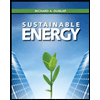
Calculate the amount of natural gas required to heat the water in a heater.
Answer to Problem 41P
The amount of natural gas required to heat the water in a heater is 72 ft3day.
Explanation of Solution
Given data:
Volume of water used per day is 80 gallons,
Initial temperature of water is, Tinitial=55 °F,
Final temperature of water is, Tfinal=140 °F,
Efficiency of heater is 80 %,
From Table 11.13 in the textbook, the specific heat of water is, c=4180 Jkg⋅K,
Standard density of water is 1000 kgm3.
Formula used:
The relationship between degree Fahrenheit and degree Celsius is,
T(°C)=59[T(°F)−32] (1)
Here,
T(°C) is the temperature in degree Celsius,
T(°F) is the temperature in degree Fahrenheit.
The formula to find thermal energy required to heat the water is,
Ethermal=mc(Tfinal−Tinitial) (2)
Here,
m is the mass of the water,
c is the specific heat of water,
Tinitial is the initial temperature of water,
Tfinal is the final temperature of water.
Calculation:
Convert the unit of volume of the water,
Volume=80 gallonsday [∴1 gallon=3.7854×10−3 m3]=(80 gallonsday)(3.7854×10−3 m31 gallon)=(80×3.7854×10−3) m3dayVolume=0.3028 m3day
Substitute 55 °F for T(°F) in equation (1) to get the initial temperature in degree Celsius,
Tinitial(°C)=59[55−32]=12.77 °C
Substitute 140 °F for T(°F) in equation (1) to get the final temperature in degree Celsius,
Tfinal(°C)=59[140−32]=60 °C
The expression to find the mass of the water is,
Mass=Volume×density=(0.3028 m3day)(1000 kgm3)Mass=302.8 kgday
Substitute 302.8 kgday for m, 4180 Jkg⋅K for c, 12.77 °C for Tinitial, and 60 °C for Tfinal in equation (2) to find Ethermal,
Ethermal=(302.8 kgday)(4180 Jkg⋅K)(60 °C−12.77 °C) [∴ °C=K]=(302.8 kgday)(4180 Jkg⋅K)(60−12.77) K
Ethermal=59.7792×106 Jday
The unit conversion on above result is,
Ethermal=59.7792×106 Jday [∴1 day=24 h]=59.7792×106 (Jday×1 day24 h) [∴1 h=3600 s]=(2.491×106 Jh)(1 h3600 s) [∴1 Js=1 W]Ethermal=693 W
Do the unit conversion on above result,
Ethermal=693 W [∴1 W=3.412 Btuh]=(693 W)(3.412 Btuh1 W)Ethermal=2364.6 Btuh
At standard 77 °F temperature, the heating value of methane is 978 Btuft3. Since the major composition of natural gas is methane, consider the heating value of natural gas is 978 Btuft3, as the range of temperature given as 55 °F to 140 °F considered for 77 °F.
Then the amount of natural gas required to heat the water in heater can be determined from the below expression:
Volume of gas=EthermalEfficiency×Heating value of gas=2364.6 Btuh0.8(978 Btuft3) [∴1 day=24 h]=(3 ft3h)(24 h1 day)Volume of gas=72 ft3day
Therefore, the amount of natural gas required to heat the water in a heater is 72 ft3day.
Conclusion:
Hence, the amount of natural gas required to heat the water in a heater is 72 ft3day.
Want to see more full solutions like this?
Chapter 11 Solutions
ENGINEERING FUNDAMENTALS
- 13. Determine the moment at supports A and B of the fixed ended beam loaded as shown using Point Load Analogous via Integration: 10 kN/m 9 kN/m 3 m 3 m 12 kN/marrow_forwardHow does construction estimate inaccuracies lead to delays and complications that impact projects?arrow_forwardQ5: Given the following system: น -3 y= [4 -2] +3u Generate a model with states that are the sum and difference of the original states.arrow_forward
- 4. Draw a stress-strain curve (in tension and compression) for a reinforced concrete beam below. Label the important parts of the plot. Find the linear elastic approximation obtained using the transformed technique, and plot over the same strain ranges. 24" 4" 20" 16" f = 8,000 psi 8- #11 bars Grade 60 steel 4" (f, = 60 ksi and E₁ = 29000 ksi)arrow_forwardWhy is Historical Data important compared to other sourses of information when estimating construction projects?arrow_forwardNeed help, please show all work, steps, units and round to 3 significant figures. Thank you!!arrow_forward
- Need help. Find the answer to the boxes marked in red. Thanks!arrow_forwardFor the gravity dam shown in the figure, The following data are available: -Unit weight of concrete (Yconc) = 2.4 ton/m³ -Vertical upward earth quake factor (K,) = 0.1 -Neglect Wave pressure, silt pressure and ice force μ=0.65 a-Find heel and toe stresses (Pmin & Pmax) b-Is this structure safe against tension? c-Find the factor of safety against sliding and overturning (F.S, & F.Sover) 165 m 160 m t 10 m T I 4 m 50 100 marrow_forwardFor the gravity dam shown in the figure, The following data are available: -Unit weight of concrete (Yeone) 2.4 ton/m³ Vertical down ward earth quake factor (K,) = 0.1 Neglect Wave pressure, silt pressure and ice force The wind velocity (V)-45 Km/hr Straight length of water expanse (F) 75 Km =0.7 14-70m 3h T a- Find the factor of safety against sliding and overturning (F.Slid F.Sover) b- Find the toe and heel stresses (hma, and hmin.) c-Check tension. 8marrow_forward
- QUESTION 2-(40 Points) In the case where other information is given in the figure, the wall is under the effect of a uniform lateral wind load of 0.7 kN/m2. Since the foundation is sized according to the safe bearing capacity of the soil and the safe bearing capacity remains the same, find the width of this foundation asymmetrically (with uniform base pressure). Draw the vertical section of the wall of the asymmetric foundation and write its dimensions and values on it. Draw the T and M diagrams along the width. The foundation thickness is the same in both cases. q=0.7 kN/m2 5 m R Duvar Nd=Wd 0.7 m T K 0 0.6 0.5 1.7 m Yb-24 kN/m3 0.6 m T + foundationarrow_forwardCan you pls. Explain on how to get "BETA T" and "BETA C" on this study about VALUE OF TRAVEL TIME.arrow_forward440 CHAPTER 9 ANALYSIS OF STATICALLY INDETERMIN 9-23. Determine the reactions at the supports, then draw the moment diagrams for each member. Assume A and B are pins and the joint at C is fixed connected. EI is constant. Se 9-2 12 kN 2 m 2 m 6 kN/m A 6 m Prob. 9-23 Barrow_forward
 Engineering Fundamentals: An Introduction to Engi...Civil EngineeringISBN:9781305084766Author:Saeed MoaveniPublisher:Cengage Learning
Engineering Fundamentals: An Introduction to Engi...Civil EngineeringISBN:9781305084766Author:Saeed MoaveniPublisher:Cengage Learning
 Sustainable EnergyCivil EngineeringISBN:9781133108689Author:Richard A. DunlapPublisher:Cengage Learning
Sustainable EnergyCivil EngineeringISBN:9781133108689Author:Richard A. DunlapPublisher:Cengage Learning Solid Waste EngineeringCivil EngineeringISBN:9781305635203Author:Worrell, William A.Publisher:Cengage Learning,
Solid Waste EngineeringCivil EngineeringISBN:9781305635203Author:Worrell, William A.Publisher:Cengage Learning,



